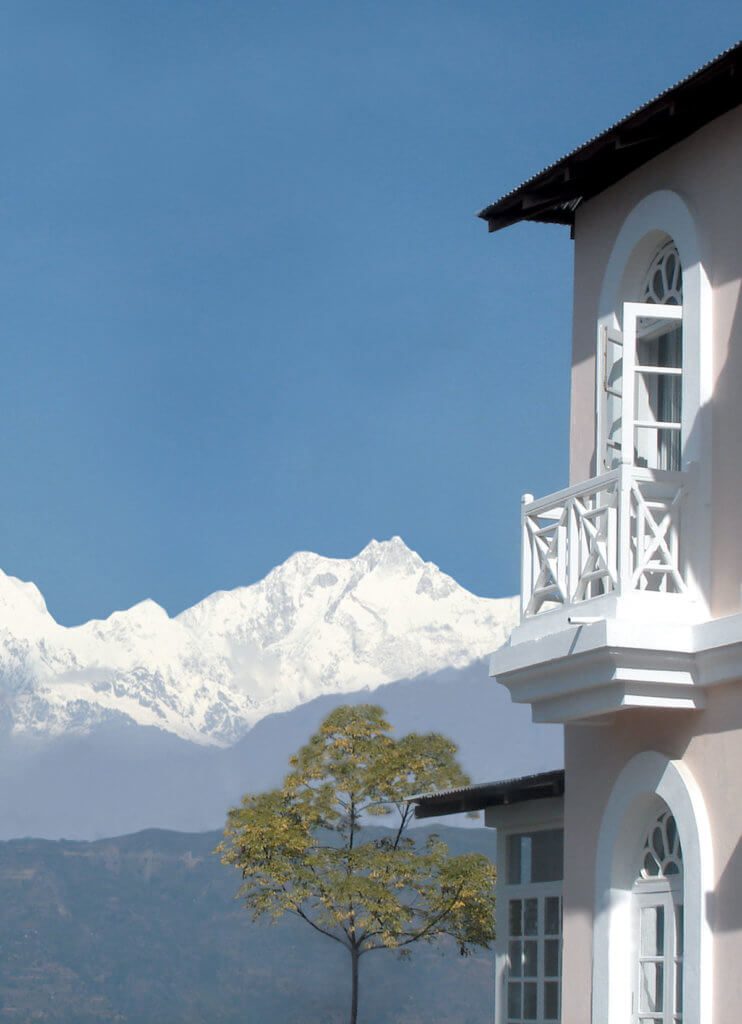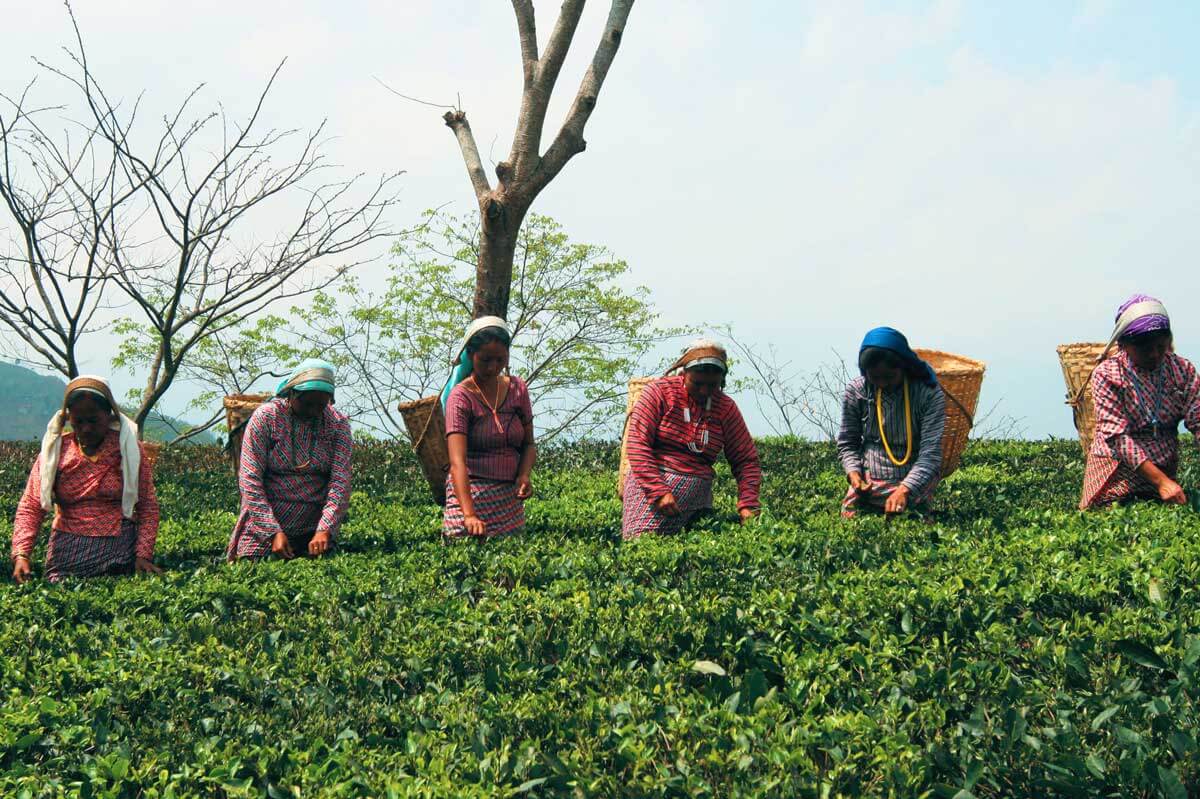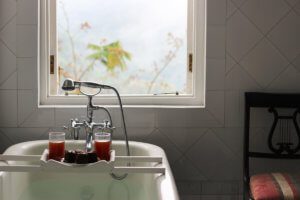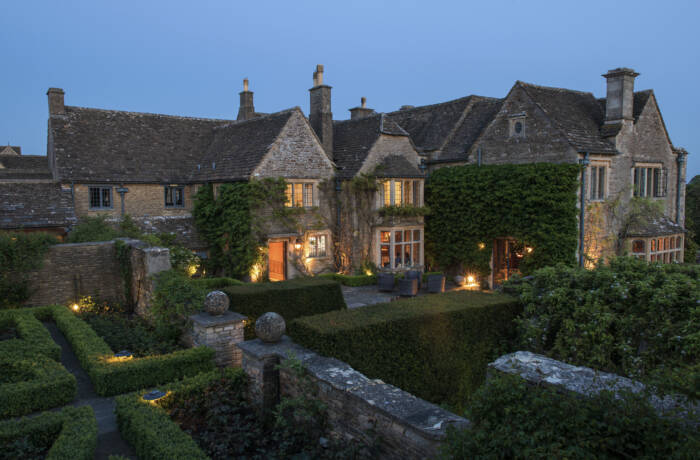
Breakfast is served alfresco at Glenburn Tea Estate on the terrace. Image by James Houston
The Himalayas are one of the few corners of the earth that remain unconquerable by humans. Many of the world’s highest peaks are yet to be summitted and much of the range is still a mystery. In the first leg of a journey from North East India to Nepal, Digital Editor Millie Walton ascends to the colonial city of Darjeeling to experience life at high altitude from the luxurious view point of Glenburn Tea Estate.
Life on the mountains begins at sunrise. The curtains of our suite are drawn at 6am with the delivery of “bed tea” ( a china teapot of the estate’s finest brew) and biscuits. The room glows pale yellow, a light which will soon turn bright and icy. We have been told that this is when the Himalayas are at their most magnificent as the sun slides down the edges of the mountains, and the snow blushes pink, then gold. This morning, however, nature won’t oblige voyeuristic eyes and the mountains are concealed by layers of puffy, white clouds. Set against, the vibrant green of Glenburn’s surrounding tea plantations, it’s still beautiful, but not quite Kanchenjunga.

Kanchenjunga, the third highest mountain in the world, sits opposite Glenburn
“You may need umbrellas. It rains almost every day here,” Jemima, our Scottish hostess warns us as we set off on a morning walk down to the Sikkim river. In the hot sun, it’s hard to believe, but the weather at high altitude is volatile and necessarily so for the healthy growth of tea. “Most people don’t realise that there are only two types of tea: Chinese and Assam. We grow both here at Glenburn,” our guide explains to us, as we stroll through the neatly combed lines of tea plants. Today is Sunday so there are no pickers at work, but there are over 1,000 employees on the estate who contribute in some way to the production of the tea. The estate, originally established by a Scottish family hence the Celtic name, is now owned and run by one of the most respected tea families in India, The Prakashes, not just as a business, but as a community. There are five villages, five schools, shops, hospitals, mosques, churches, Hindu and Buddhist temples on Glenburn’s hillsides. Lives are created and lived on the same soil from which the tea grows. It’s not something you tend to think about when you sit down for a cup of afternoon tea, but of course, most of the brands we are familiar with don’t have that kind of heritage, in fact, we’re told, a large percentage of the tea bags we dip into boiling water are stuffed with the leftover scrapings of leaves, the bad, cheap stuff. Unwittingly, our tastebuds have been dulled into acceptance of mediocre.
Read next: Hotel Byblos owner, Antoine Chevanne on intimate luxury
The Glenburn estate isn’t actually in the town of Darjeeling, and whilst it’s only 6 km away (as the crow flies), it’s a painful hour’s jeep ride along mountain roads and down dirt tracks to reach the pretty green and white cottages that sit on a well kept, mountainside shelf (each morning the postman makes the journey to deliver the daily newspaper). So it’s remote enough not to see or hear the deafening horns of India’s jostling traffic, which somehow still manages to infiltrate the lower parts of Darjeeling. Walking down an increasingly steep track to the river, the only sound is the singing of birds. The lower we descend, the more jungle like the landscape becomes – the mountains here are so vast that they support multiple ecosystems – and we arrive at the riverside campsite glistening. Here more adventurous guests can camp for a night in the basic, comfortable lodge, but compared to the four poster bed in our bright and spacious floral suite, we decide lunch will suffice.

Tea pickers on the estate
The river, flowing fast with ice cold, glacial mountain water, is the border between West Bengal and Sikkim, and whilst Indians can move freely between the two states (we meet two men returning to a Glenburn village later on with baskets of beer hanging from their foreheads, as alcohol is cheaper across the water), foreigners require a permit to cross the bridge so all we can do is peer through the distant trees. The journey back is by jeep – luxury travel gives guests the option to choose the intensity of their adventure – and the clouds are still stubbornly blocking our view, smouldering with coming rain. Come nightfall though, the mountains around us are blinking with thousands of lights revealing the isolated communities that are hidden during the day. At a higher level, the sky seems even more black and endless filled with the vibrations of cicadas.

The Singalila Suite

Views from the bathtub. Image by James Houston
Dinner is served formally at 8pm, following colonial tradition, round a communal dining table after drinks in the drawing room. On the first night, guests timidly trot round the edge to find their place name, smiling shyly at their neighbour, but conversation flows freely after a few glasses of wine; the remoteness of Glenburn appears to attract a more worldly and relaxed type of traveller in comparison to city smart hotels. The menu is themed each night according to the produce the estate has been able to source, and whilst it’s not quite Michelin star quality gastronomy, the chefs do well with the limited resources, often incorporating tea into dishes in innovative ways. It’s a languid, indulgent and homely evening. The very charm of Glenburn lies in its unpretentiousness and eccentricity; each room is furnished with beautiful, “lived-in” antiques, battered board games are stuffed onto shelves amongst well read books, there are no locks on any doors and guests are free to wander without butlers pouncing on them to ask if they’d like another drink. It’s a nostalgic world that could not exist anywhere else, but the foothills of the Himalayas.
Read next: Haute cuisine at high altitude in Zermatt
That night, I’m awoken by the reverberating drumming of an insect calling out hopelessly into the darkness for a female. It’s almost 2am, hours from sunrise and yet… I draw back the curtains and in the silvery light of the moon glimpse the jagged edge of a luminous mountain, just visible for a moment before a shadow moves across the sky. There’s something reassuringly calming though, just knowing that the mountains are and always will be there.








